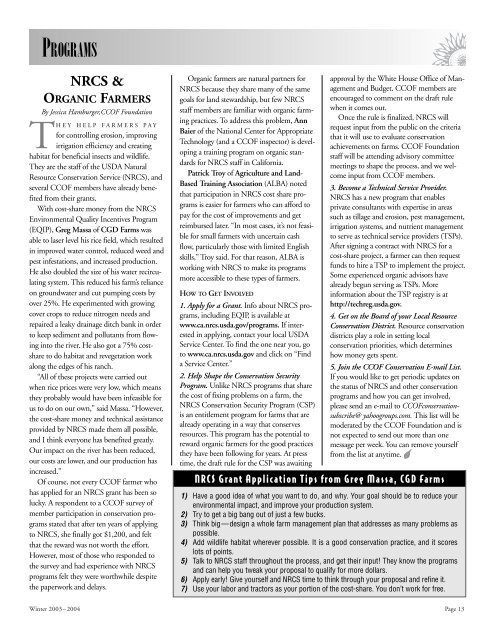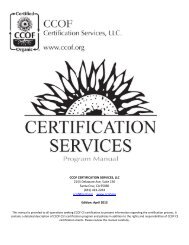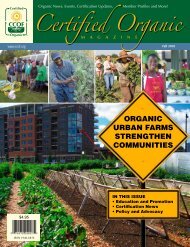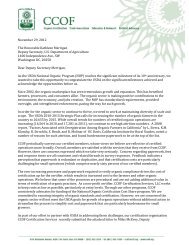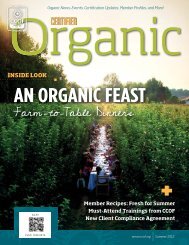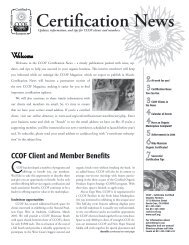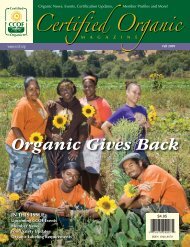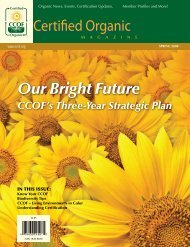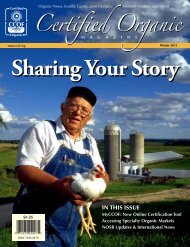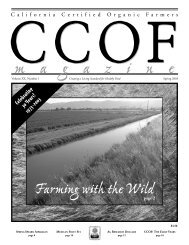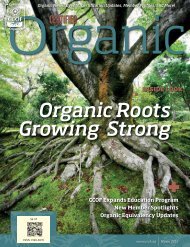Consolidation in Organic Agriculture - CCOF
Consolidation in Organic Agriculture - CCOF
Consolidation in Organic Agriculture - CCOF
You also want an ePaper? Increase the reach of your titles
YUMPU automatically turns print PDFs into web optimized ePapers that Google loves.
PROGRAMSNRCS &ORGANIC FARMERSBy Jessica Hamburger,<strong>CCOF</strong> FoundationTH EY HELP FARMERS PAYfor controll<strong>in</strong>g erosion, improv<strong>in</strong>girrigation efficiency and creat<strong>in</strong>ghabitat for beneficial <strong>in</strong>sects and wildlife.They are the staff of the USDA NaturalResource Conservation Service (NRCS), andseveral <strong>CCOF</strong> members have already benefitedfrom their grants.With cost-share money from the NRCSEnvironmental Quality Incentives Program(EQIP), Greg Massa of CGD Farms wasable to laser level his rice field, which resulted<strong>in</strong> improved water control, reduced weed andpest <strong>in</strong>festations, and <strong>in</strong>creased production.He also doubled the size of his water recirculat<strong>in</strong>gsystem. This reduced his farm’s relianceon groundwater and cut pump<strong>in</strong>g costs byover 25%. He experimented with grow<strong>in</strong>gcover crops to reduce nitrogen needs andrepaired a leaky dra<strong>in</strong>age ditch bank <strong>in</strong> orderto keep sediment and pollutants from flow<strong>in</strong>g<strong>in</strong>to the river. He also got a 75% costshareto do habitat and revegetation workalong the edges of his ranch.“All of these projects were carried outwhen rice prices were very low, which meansthey probably would have been <strong>in</strong>feasible forus to do on our own,” said Massa. “However,the cost-share money and technical assistanceprovided by NRCS made them all possible,and I th<strong>in</strong>k everyone has benefited greatly.Our impact on the river has been reduced,our costs are lower, and our production has<strong>in</strong>creased.”Of course, not every <strong>CCOF</strong> farmer whohas applied for an NRCS grant has been solucky. A respondent to a <strong>CCOF</strong> survey ofmember participation <strong>in</strong> conservation programsstated that after ten years of apply<strong>in</strong>gto NRCS, she f<strong>in</strong>ally got $1,200, and feltthat the reward was not worth the effort.However, most of those who responded tothe survey and had experience with NRCSprograms felt they were worthwhile despitethe paperwork and delays.<strong>Organic</strong> farmers are natural partners forNRCS because they share many of the samegoals for land stewardship, but few NRCSstaff members are familiar with organic farm<strong>in</strong>gpractices. To address this problem, AnnBaier of the National Center for AppropriateTechnology (and a <strong>CCOF</strong> <strong>in</strong>spector) is develop<strong>in</strong>ga tra<strong>in</strong><strong>in</strong>g program on organic standardsfor NRCS staff <strong>in</strong> California.Patrick Troy of <strong>Agriculture</strong> and Land-Based Tra<strong>in</strong><strong>in</strong>g Association (ALBA) notedthat participation <strong>in</strong> NRCS cost share programsis easier for farmers who can afford topay for the cost of improvements and getreimbursed later. “In most cases, it’s not feasiblefor small farmers with uncerta<strong>in</strong> cashflow, particularly those with limited Englishskills,” Troy said. For that reason, ALBA iswork<strong>in</strong>g with NRCS to make its programsmore accessible to these types of farmers.HOW TO GET INVOLVED1. Apply for a Grant. Info about NRCS programs,<strong>in</strong>clud<strong>in</strong>g EQIP, is available atwww.ca.nrcs.usda.gov/programs. If <strong>in</strong>terested<strong>in</strong> apply<strong>in</strong>g, contact your local USDAService Center. To f<strong>in</strong>d the one near you, goto www.ca.nrcs.usda.gov and click on “F<strong>in</strong>da Service Center.”2. Help Shape the Conservation SecurityProgram. Unlike NRCS programs that sharethe cost of fix<strong>in</strong>g problems on a farm, theNRCS Conservation Security Program (CSP)is an entitlement program for farms that arealready operat<strong>in</strong>g <strong>in</strong> a way that conservesresources. This program has the potential toreward organic farmers for the good practicesthey have been follow<strong>in</strong>g for years. At presstime, the draft rule for the CSP was await<strong>in</strong>gapproval by the White House Office of Managementand Budget. <strong>CCOF</strong> members areencouraged to comment on the draft rulewhen it comes out.Once the rule is f<strong>in</strong>alized, NRCS willrequest <strong>in</strong>put from the public on the criteriathat it will use to evaluate conservationachievements on farms. <strong>CCOF</strong> Foundationstaff will be attend<strong>in</strong>g advisory committeemeet<strong>in</strong>gs to shape the process, and we welcome<strong>in</strong>put from <strong>CCOF</strong> members.3. Become a Technical Service Provider.NRCS has a new program that enablesprivate consultants with expertise <strong>in</strong> areassuch as tillage and erosion, pest management,irrigation systems, and nutrient managementto serve as technical service providers (TSPs).After sign<strong>in</strong>g a contract with NRCS for acost-share project, a farmer can then requestfunds to hire a TSP to implement the project.Some experienced organic advisors havealready begun serv<strong>in</strong>g as TSPs. More<strong>in</strong>formation about the TSP registry is athttp://techreg.usda.gov.4. Get on the Board of your Local ResourceConservation District. Resource conservationdistricts play a role <strong>in</strong> sett<strong>in</strong>g localconservation priorities, which determ<strong>in</strong>eshow money gets spent.5. Jo<strong>in</strong> the <strong>CCOF</strong> Conservation E-mail List.If you would like to get periodic updates onthe status of NRCS and other conservationprograms and how you can get <strong>in</strong>volved,please send an e-mail to <strong>CCOF</strong>conservationsubscribe@yahoogroups.com. This list will bemoderated by the <strong>CCOF</strong> Foundation and isnot expected to send out more than onemessage per week. You can remove yourselffrom the list at anytime.NRCS Grant Application Tips from Greg Massa, CGD Farms1) Have a good idea of what you want to do, and why. Your goal should be to reduce yourenvironmental impact, and improve your production system.2) Try to get a big bang out of just a few bucks.3) Th<strong>in</strong>k big—design a whole farm management plan that addresses as many problems aspossible.4) Add wildlife habitat wherever possible. It is a good conservation practice, and it scoreslots of po<strong>in</strong>ts.5) Talk to NRCS staff throughout the process, and get their <strong>in</strong>put! They know the programsand can help you tweak your proposal to qualify for more dollars.6) Apply early! Give yourself and NRCS time to th<strong>in</strong>k through your proposal and ref<strong>in</strong>e it.7) Use your labor and tractors as your portion of the cost-share. You don’t work for free.W<strong>in</strong>ter 2003–2004 Page 13


